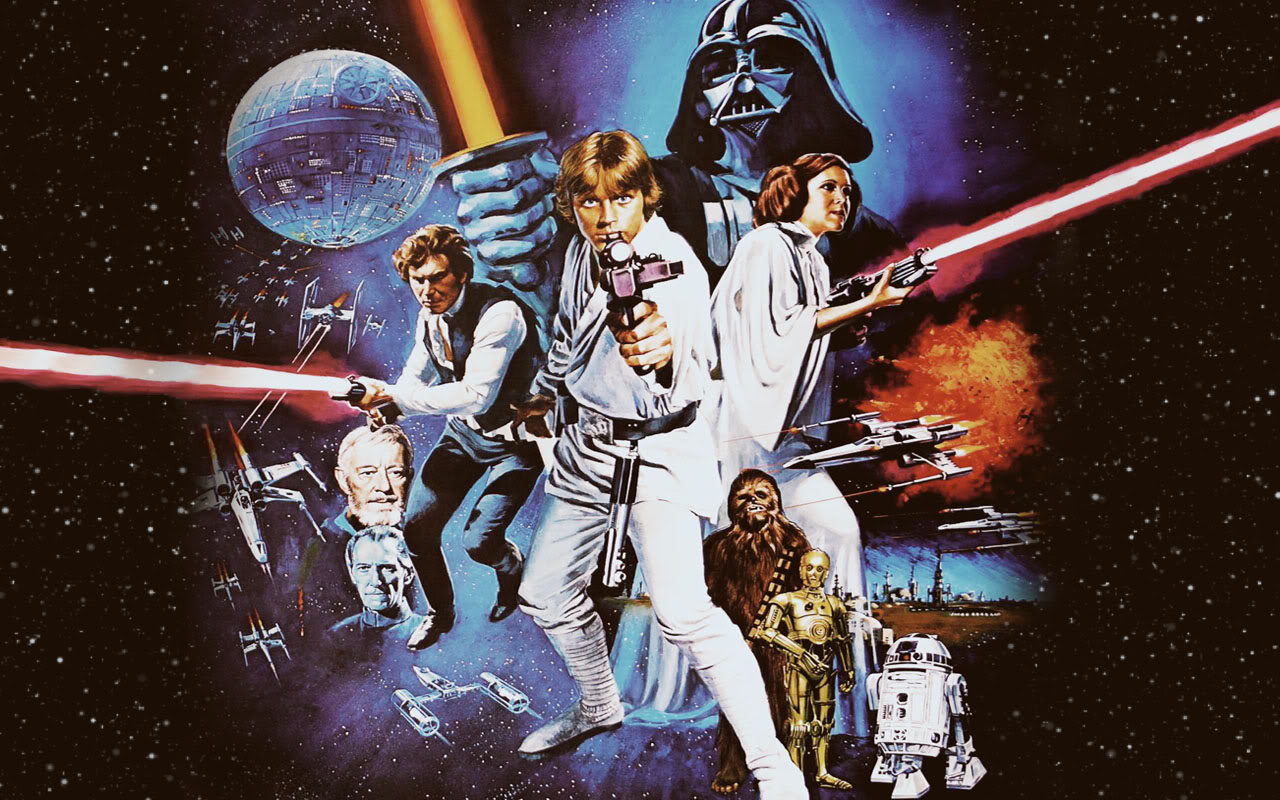Journey
Act I. Departure
“A hero ventures forth from the world of common day into a region of supernatural wonder.”
45 INT. KENOBI’S DWELLING BEN You must learn the ways of the Force if you're to come with me to Alderaan. LUKE (laughing) Alderaan? I'm not going to Alderaan. I've got to go home. It's late, I'm in for it as it is. BEN I need your help, Luke. She needs your help. I'm getting too old for this sort of thing. LUKE I can't get involved! I've got work to do! It's not that I like the Empire. I hate it! But there's nothing I can do about it right now. It's such a long way from here.
53 EXT. TATOOINE - WASTELAND There is a large bonfire of Jawa bodies blazing in front of the Sandcrawler as Ben and the robots finish burning the dead. Luke drives up in the speeder and Ben walks over to him. BEN There's nothing you could have done, Luke, had you been there. You'd have been killed, too, and the droids would be in the hands of the Empire. LUKE I want to come with you to Alderaan. There's nothing here for me now. I want to learn the ways of the Force and become a Jedi like my father.
Act II. Initiation
“Fabulous forces are there encountered and a decisive victory is won.”
474 INT. DEATH STAR An Imperial soldier runs to the control panel board and pulls the attack lever as the board behind him lights up. INTERCOM VOICE Stand by to fire at Rebel base.
477 EXT. SPACE AROUND THE DEATH STAR The Rebel ships race out of sight, leaving the moon-like Death Star alone against a blanket of stars. Several small flashes appear on the surface. The Death Star bursts into a supernova, creating a spectacular heavenly display.
478 INT. MILLENNIUM FALCON – COCKPIT HAN Great shot, kid. That was one in a million.
Act III. Return
“The hero comes back from this mysterious adventure with the power to bestow boons on his fellow man.”
479 INT. LUKE'S X-WING FIGHTER – COCKPIT Luke is at ease, and his eyes are closed. BEN'S VOICE Remember, the Force will be with you... always.
***
The hero’s journey
In “The Hero with a Thousand Faces” (1949, first edition), Joseph Campbell provided a work of art on comparative mythology across geography and time. After studying all classic religious texts, he observed that the stories of Buddha, Moses, Jesus, or Mohammed, just like that of other spiritual and folkloric texts, share a basic structure—the “monomyth”—about an archetypal “Hero’s Journey” [1]. Campbell concluded that any mythological hero’s tale adventure follows a formula represented by three phases, or rites of passage, each constituted by different sections:
Departure/Separation
The call to adventure, refusal of the call, meeting the supernatural aid, crossing the threshold, belly of the whale.
Initiation
The road of trials, the meeting with the goddess, woman as temptress, atonement with the father, apotheosis, the ultimate boon (the quest is fulfilled).
Return
Refusal of the return, the magic flight, rescue from without, the crossing of the return threshold, master of the two worlds, freedom to live.
Before Campbell, in the “Morphology of the Folktale” (1928), Vladimir Propp also identified common sections (or functions) and basic characters (including “the hero” and “the villain”) present in the 100 Russian folktales that he studied [2]. Other variations have been put forward, but most stick to the three-act structure dominating most Hollywood movies today.
Storyphiliacs
Professor of comparative literature, writer, and movie producer Ken Atchity argues that we like three-act fictional stories because they give us “closure,” a piece of fulfillment in this complicated life [3]. But we are not easily pleased with easy stories. We want to watch dramas. We want to see shero suffering, losing everything, falling into despair,… just to delight ourselves when she re-emerges from her ashes, transformed, taking control of her life. The best stories give us this formula, but not all the details.
We love puzzles. Social psychologist Daniel Gilbert says that unexplained events create a bigger emotional impact [4]. On the one hand, they come across as unusual and exciting. In addition, when there is enough mystery left, we keep thinking about it. We discuss our theories with our friends. We seek an explanation. We need an explanation.
Good storytelling engages the audience’s imagination. Provide a round-up explanation, even a fake one, and we are ready to move on to the next thing. Novelists and filmmakers have learned how to use this knowledge. It is no accident that Star Wars continue to engage our imagination to this day. Part of its original success related to the rich details of the world depicted in it, which was hard to follow (and understand!) due to the movie’s fast pace. But more critically, George Lucas was probably the pioneer in deliberately implementing the Hero’s Journey formula into a Hollywood movie. Thanks to his background in Anthropology, Lucas was aware of Campbell’s work [5]. He just decided to tell the same old tale but in space, “in a galaxy far, far away…”
Given that evolutionary explanation is by definition a kind of narration, paleoanthropologists might consider wrestling with the ‘story-telling dragon’
Misia Landau, Narratives in Human Evolution (1993)
Narratives in human evolution
Our tendency to tell stories, and our eagerness to listen to them, extends outside the realm of fiction. Indeed, many accounts about human origins are constructed borrowing elements from the Hero’s Journey myth structure [6]. For example, they feature a humble hero (our ape ancestor) who departs on a journey (is forced out of its jungle homeland to endure the harsh savanna), receives essential equipment from a helper or donor figure (stone tools, language), goes through tests and transformations (bipedal locomotion, enlarged brain), and finally arrives at a higher state (the origins of modern civilization).
In many cases, researchers unconsciously fit every new piece of information, or new fossil, into a pre-existing narrative (I am guilty too). Even the Modern Synthesis encapsulates pre-Darwinian (sometimes religious) concepts into the narrative of the theory: Our genotype (DNA) symbolizes the “immortal soul” contained and transmitted through generations using transitory phenotypes (our bodies), the vessels our of spirit.
Human evolution is a fact. The fossil and archeological records indicate how much we have changed over time. But the causes leading to each evolutionary step are blurry. Creating a narrative is helpful to organize our ideas. But we should be aware of our storytelling bias when constructing evolutionary scenarios, so they are based on theories built upon falsifiable hypotheses. Historical sciences are no easy task. We think we know how the story ends, so we re-create the past from there.
Wired
We simply cannot stop telling stories. The ability to tell good stories, as well as our love for them, could be innate to all of us. These are a few major examples of its adaptive advantages [7]:
- Manipulating the behavior of the audience to enhance the fitness of the narrator. A good storyteller could also be an ill-intentioned politician.
- Transmitting information essential for our survival without facing the actual experiences that would lead to acquiring that knowledge directly. Would you like to taste all the colorful mushrooms that you encounter during your walk in the woods?
- Maintaining social bonds and group cooperation. This has an important developmental component. Think of every time we were told fables as a kid or indoctrinated in a particular religion.
- Making sense of new situations, collectively. It involves effective communication to identify a common cause, a vision, and reaching consensus to find the best path moving forward. A good leader is a good storyteller. “I have a dream,” said Dr. King.
***
A hero is one who wants to be himself.
José Ortega y Gasset
Star Wars and other success stories such as The Hobbit, Harry Potter, The Lion King, or The Matrix represent a different twist on essentially the same idea. They all follow the pattern of the Hero’s Journey tale. Joseph Campbell, like Carl Jung, would argue that these stories resonate with all of us because they represent a universal myth engraved in our souls. Or, if you wish, this myth is part of a software (DNA) controlling our feelings at the deepest level, naturally selected during evolution.
These stories carry an important message in their theme: “change is the rule of life,” “you can’t escape your demons, only face them,” “be courageous, and you’ll succeed.” However, given the limitations of human memory, self-contained stories following a particular pattern might have been the most straightforward way to remember fundamental truths carried through generations since the beginning of storytelling.
Our life storylines are full of calls to action, trials, help from friends, villains, and returns. Thankfully, no matter how challenging the situation, we can always ask: What would the s/hero of this story do?
Notes
[1] The word monomyth is from James Joyce, Finnegans Wake (New York: Viking Press Inc. 1939), p. 581.
[2] A comparison between the story structures of Joseph Campbell and Vladimir Propp can be found in this link.
[3] Atchity, Kenneth John. A Writer’s Time: Making the Time to Write. WW Norton & Company, 1995.
[4] Gilbert, Daniel. Stumbling on Happiness. Vintage Canada, 2009.
[5] Joseph Campbell himself discussed The Power of Myth in a series of conversations with Bill Moyers filmed at Lucas’ Skywalker Ranch (subsequently broadcasted in 1988).
I also recommend watching the conversation between George Lucas and Christopher Nolan on the story behind the impact of the Star Wars saga.
[6] This idea is presented in Landau’s book:
Landau, Misia. Narratives of Human Evolution. Yale University Press, 1993.
there, Landau quotes Cartmill (1983):
Cartmill, Matt. “Four legs good, two legs bad: Man’s place (if any) in nature.” Natural History 92, no. 11 (1983): 65-79.
Caporael (1994) develops further the topic:
Caporael, Linnda R. “Of myth and science: Origin stories and evolutionary scenarios.” Social Science Information 33, no. 1 (1994): 9-23. https://doi.org/10.1177/053901894033001002.
[7] Bietti et al. (2019) reviewed the alternative hypotheses, and proposed a new one:
Bietti, Lucas M., Ottilie Tilston, and Adrian Bangerter. “Storytelling as adaptive collective sensemaking.” Topics in Cognitive Science 11, no. 4 (2019): 710-32. https://doi.org/10.1111/tops.12358.
Thanks to Joseph Campbell, George Lucas, Steven Pressfield, Misia Landau, and Ken Atchity for introducing me to the real value of the Hero’s Journey.
The script text at the beginning and the cover image belong to Star Wars: Episode IV – A New Hope (Credit: Lucasfilm Ltd., Twentieth Century-Fox).

